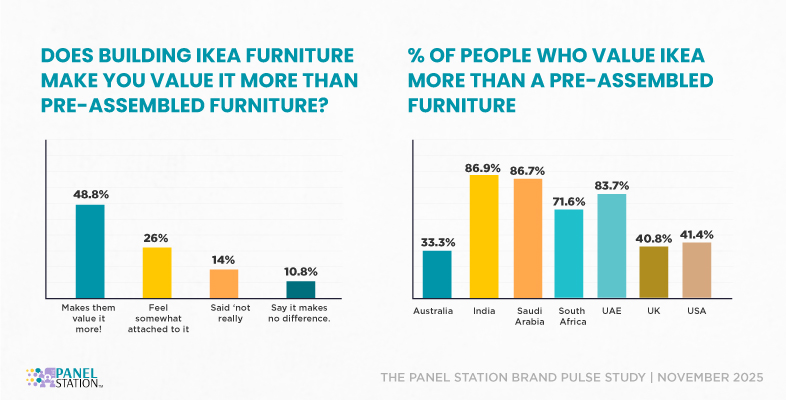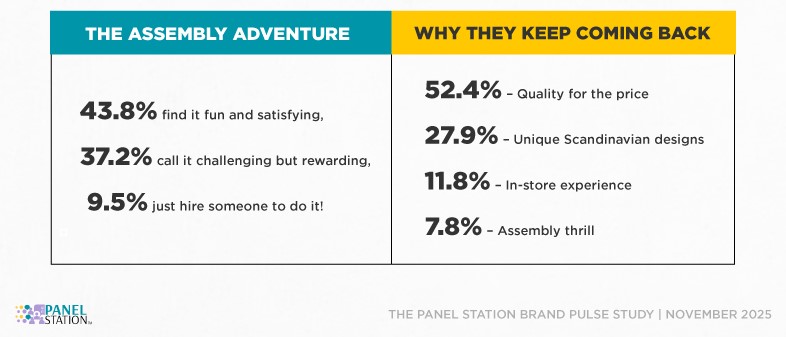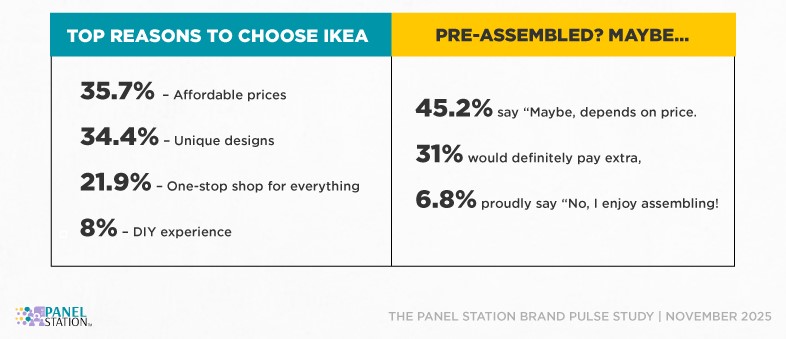

Does Building Your IKEA Furniture Make You Love It More? Here's What People Said
There’s something about IKEA furniture that sticks with you long after you’ve brought it home. Maybe it’s the hours spent decoding wordless instructions, or maybe it’s because you earned every piece through sweat and determination.
The Panel Station recently ran a survey across seven markets (India, Australia, the USA, KSA, UAE, South Africa, and the UK) to understand what IKEA really means to people.
For some, IKEA is a love language. For others, it’s a relationship test disguised as a furniture brand. But across continents and cultures, one thing is clear that IKEA is not just about furniture; it’s about feelings.
Because behind every Allen key is a story of pride, patience, and the quiet victory of saying, “I built this.”

Share Your Opinions, Shape The Brands That Feels Right for You
Have You Shopped at IKEA
In India, it’s a new wave of modern living. The young crowd sees it as a slice of Scandinavian simplicity in bustling cities. In the UK, it’s tradition. People have grown up with IKEA catalogs on their coffee tables. In the US, it’s practicality; in Australia, it’s lifestyle; in South Africa and the UAE, it’s status mixed with function.
Whether it’s your first apartment, a dorm room, or a new family home, an IKEA trip often marks a new beginning. It’s that moment when adulthood feels real, when you realize your parents aren’t here to build your wardrobe anymore.
And yet, no matter the market, the story starts the same way: with big blue bags, flat boxes, and dreams of minimalist perfection.

Why IKEA ?
When asked why they choose IKEA, respondents across all seven countries said variations of the same thing — it’s stylish, affordable, and convenient. But dig a little deeper, and you’ll find emotional undercurrents that numbers can’t explain.
IKEA isn’t just about buying a chair; it’s about buying the idea of control. You decide the color, the design, the feel and then, you bring it to life.
Sure, the process involves decoding hieroglyphic-like instructions and losing a few screws (literally), but at the end of it, you’ve created something tangible.
It’s also about the vibe. IKEA stores are sensory playgrounds, curated lighting, mock apartments, cinnamon roll aroma wafting through the air, and Swedish names that no one can pronounce but everyone loves trying (“Did we just buy a FJÄLLBO or a FLÄRKE?”).
And yes, the meatballs help too. Because most people need fuel before assembling a 56-step bookshelf.

The IKEA Effect
Ask anyone who’s ever built IKEA furniture, and you’ll get one of two reactions: an emotional sigh of pride or a traumatic flashback.
When people across our survey were asked how they felt assembling IKEA furniture, the answers ranged from empowered to exhausted. But one word kept coming up — accomplished.
Psychologists actually have a term for this The IKEA Effect, where we value things more when we’ve put effort into creating them. It’s the emotional reward of seeing your work take shape, screw by screw.
Still, IKEA has managed to make assembly part of its brand charm. The process is not just about furniture; it’s about patience, teamwork, and occasionally questioning your relationship choices. Because if a couple can survive assembling a MALM dresser, they can survive anything.
But not everyone is a DIY devotee. A small chunk of respondents admitted they’d gladly pay extra for pre-assembled furniture. The modern world, after all, is built on convenience, and IKEA’s challenge is balancing that convenience with its do-it-yourself DNA.
The Emotional Connect
When people were asked if they felt emotionally attached to IKEA furniture they built themselves, a surprising number said yes.
A family in Australia might still have that first dining table they assembled together. A young couple in India might have laughed their way through putting together a couch.
This emotional ownership is part of IKEA’s secret magic. It transforms functional furniture into personal artifacts.


If IKEA Went Pre-Assembled — Would We Still Care?
We asked this question directly: If IKEA stopped offering DIY furniture and sold only pre-assembled pieces, would you still shop there?
While many said they’d still buy IKEA products for their design and affordability, a strong group admitted it just wouldn’t feel the same. Without the DIY element, IKEA loses its essence; that sense of creation and pride that comes from saying, “I built this myself.”
The brand’s identity is deeply tied to the experience as much as the end result.
Of course, a few people confessed they’d happily trade a few screws for sanity. But overall, the message was clear: IKEA’s charm lies not in perfection, but in participation.
Why We Keep Coming Back
Despite the occasional frustration, people keep returning to IKEA and for good reason.
When asked what keeps them coming back, most respondents pointed to a mix of product design, store experience, and affordability. But many also mentioned something deeper — the vibe.
Walking through an IKEA store is like stepping into a lifestyle, each room setup whispers, “This could be your home.” It’s aspirational, yet accessible. The products feel modern but warm, minimal but lived-in.
And then there’s the fun factor. IKEA isn’t a typical store visit; it’s an adventure. You don’t just “pop in” for a lamp. You lose two hours, a sense of direction, and your weekend plan.
But somehow, you leave smiling with a cart full of tealight candles you didn’t know you needed and a renewed belief that maybe, just maybe, you’re good at adulting.
Quality, Quantity, and Quirks
Most agree that IKEA offers great value for money. Its designs are practical, sleek, and versatile, perfect for apartments, dorms, and starter homes. But there’s also a shared understanding: it’s not forever furniture.
In a world chasing durability and sustainability, some critics argue that IKEA products aren’t built to last decades. Yet, that’s not necessarily a flaw. It’s a reflection of how we live today.
People move more, redecorate often, and evolve their homes with changing lifestyles. IKEA fits perfectly into that rhythm.
Final Thought
As lifestyles evolve and convenience becomes king, IKEA faces a delicate balance. People want faster solutions, but they also crave the satisfaction of doing things themselves.
Perhaps that’s the beauty of IKEA’s legacy. It sits perfectly between effort and ease.
It reminds us that good things often come in pieces. That the act of building something brings a sense of accomplishment no pre-assembled delivery can replicate.
Maybe that’s why, despite all the missing screws, confusing manuals, and four-hour builds, we keep going back. Because deep down, we know that IKEA furniture, like life, feels more valuable when we’ve put a bit of ourselves into it.

Your opinions shape things you love, Make your voice count by sharing your opinions.
About Author : Soneeta
A bookworm at heart, traveler by soul, and a sports enthusiast by choice. When she is not exploring new places, you’ll find her curled up with her pets, binge-watching movies. Writing is her forever sidekick. Soneeta believes that stories are the best souvenirs you can collect. Basically, she is fueled by books, adventures, and a whole lot of pet cuddles.
